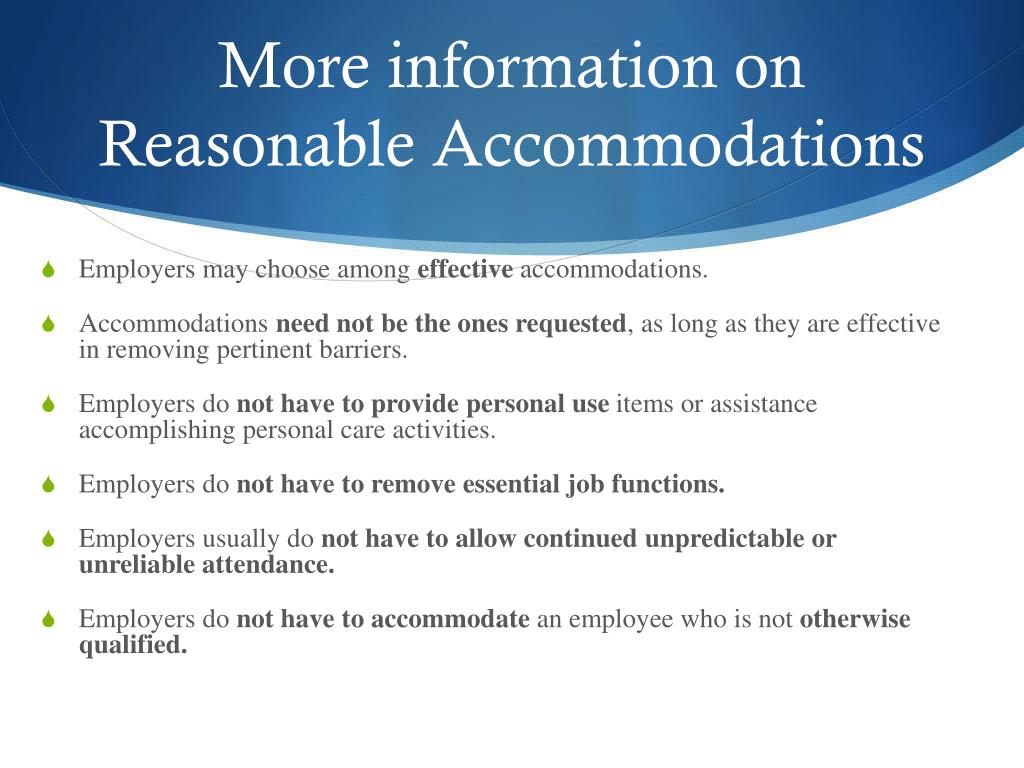
STEP THREE: If you can’t accommodate, is transfer or leave an option? Look carefully at the employee’s requested accommodation and if you don’t think it is reasonable, offer an alternative. Whether the proposed accommodation poses an undue hardship, such as by dramatically increasing costs or affecting productivity, is also a consideration, but in practice, that can be tough to prove. Get expert input on whether any proposed changes would work or if they would increase danger. In assessing whether the employee’s performance of the job poses a direct threat, be objective. You may, however, have to reassign or eliminate non-essential functions. You do not have to remove essential functions and create a new job for the employee. Keep an eye on the essential functions of the job. A request is not reasonable if it eliminates an essential job function, poses a direct threat of imminent harm, or imposes an undue hardship. STEP TWO: Determine if the requested accommodation is reasonable.Ī reasonable accommodation enables the employee to perform the essential functions of a job.


This is a process, so it could take several conversations. Keep your questions about the disability job-related and consistent with business necessity. I have found that what employees want and what their doctors say they need are not always the same thing.

You can and should get the employee’s doctor’s input on this. Don’t assume that this employee’s depression/anxiety disorder/PTSD is the same as another employee’s or anyone else’s. Your first discussion is for you to collect information, so let the employee do the talking. What, if any, restrictions has the doctor provided?.What reasonable accommodations does the employee think would enable him or her to perform those functions?.With which essential functions does the employee struggle?.The ADA requires that you engage in an interactive process, so talk with the employee. So, as a brief refresher, here are some steps to follow once your employee says he or she is suffering from a mental disability and needs a reasonable accommodation: STEP ONE: Engage in the interactive process. We have talked before about your general obligations under the ADA. In my practice I am seeing more and more requests for reasonable accommodations for stress and anxiety and, unfortunately, this is not always an easy process to manage. This means that if you haven’t yet had an employee disclose a mental disability, it is probably just a matter of time. The experts tell us that one in five adults is living with a mental illness, and 18 percent of adults in the U.S. Some general examples of disabilities we accommodate include, but are not limited to, depression, anxiety, hearing/vision/mobility conditions, chronic illnesses, psychological diagnoses, learning disabilities, ADHD, traumatic brain injury, and Autism Spectrum Disorder.What do you do when an employee discloses that he or she is stressed out and needs a reasonable accommodation under the Americans with Disabilities Act, but the requested accommodation strikes you as unreasonable? If you are reading this and thinking “that won’t happen to me-all of my employees are well-adjusted,” think again.
Ada accommodations for anxiety manual#
Major life activities include, but are not limited to, caring for oneself, performing manual tasks, seeing, hearing, eating, sleeping, walking, standing, lifting, bending, speaking, breathing, learning, reading, concentrating, thinking, communicating, and working. We strive to promote an appreciation of every student and the unique strengths and attributes they bring along with them.Īccording to the ADA Amendments Act of 2008, a disability is a physical or mental impairment that substantially limits one or more major life activities. Disability can take many different forms – some are apparent while others are not. In our office, we value disability as yet another component of the incredible diversity found on this campus. College Support Program for Students on Autism Spectrum.

Creating Accessible and Inclusive Meetings or Events.


 0 kommentar(er)
0 kommentar(er)
